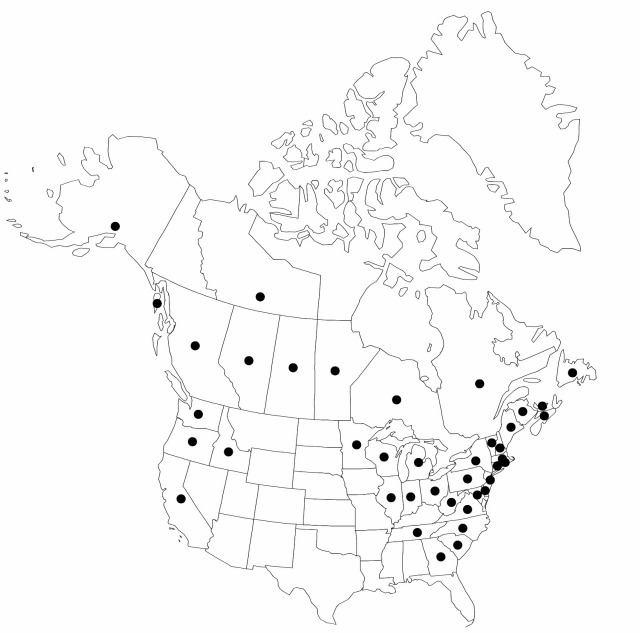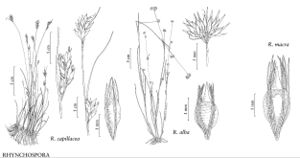Rhynchospora alba
Enum. Pl. 2: 236. 1805.
Plants perennial, densely cespitose, 6–75 cm; rhizomes mostly absent. Culms erect to curved, leafy, obscurely trigonous to nearly terete, few ribbed, slender. Principal leaves mostly overtopped by culm; blades narrowly linear to filiform, proximally flat, 0.5–1.5 mm, apex tapering, trigonous. Inflorescences: clusters 1 or 2–3, then widely spaced, narrowly turbinate to hemispheric, 1.5–2.5 cm wide; subtending leafy bracts often exceeded by distal cluster. Spikelets pale brown to nearly white, ellipsoid, 3.5–5.5 mm, apex acute; fertile scales elliptic, 3–3.5(–4) mm, apex acute or acuminate, midrib excurrent as mucro. Flowers: perianth bristles 10–12, slightly overtopping tubercle, retrorsely barbellate or rarely smooth, base often setose. Fruits 1(–2) per spikelet, (2.3–)2.5–3 mm; body pale brown with paler center, stipitateobovoid, lenticular, 1.5–1.8(–2) × 0.9–1.2 mm; surfaces transversely striate, relatively smooth, rim narrow, flowing to tubercle base; tubercle narrowly triangularsubulate, 0.5–1.2 mm.
Phenology: Fruiting summer–fall.
Habitat: Acid, sphagnous, boggy, open sites, poor fens, often on floating mats or peaty interstices of rocky shores
Elevation: 0–2000 m
Distribution

Alta., B.C., Man., N.B., Nfld. and Labr. (Nfld.), N.W.T., N.S., Ont., P.E.I., Que., Sask., Alaska, Calif., Conn., Del., Fla.(?), Ga., Idaho, Ill., Ind., Maine, Md., Mass., Mich., Minn., N.H., N.J., N.Y., N.C., Ohio, Oreg., Pa., R.I., S.C., Tenn., Vt., Va., Wash., W.Va., Wis., West Indies (Puerto Rico), South America(?), Eurasia.
Discussion
The smooth-bristled Rhynchospora alba forma laeviseta Gale mostly occurs with the typical antrorsely barbellate type in Pennsylvania, the Great Lakes, British Columbia, Newfoundland, and Nova Scotia.
Selected References
None.
